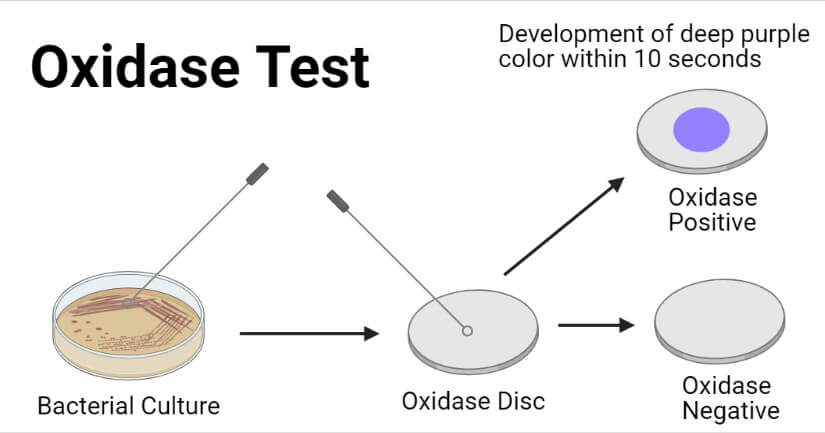Oxidase Test- Principle, Procedure and Results
Objective of Oxidase Test
To determine the ability of the organism to produce the cytochrome oxidase enzyme.
Principle of Oxidase Test
The oxidase test is designed for specifically detecting the presence of the terminal enzyme system in aerobic respiration called cytochrome C oxidase or cytochrome a3. Cytochrome C oxidase is the terminal or last H2 electron acceptor in an aerobic respiratory mechanism which is composed of a number of enzymes that alternatively oxidize and reduce each other by donating or accepting electrons derived from H2.
The ability of an organism to produce the cytochrome C oxidase can be determined by using the reagent tetramethyl-p-phenylenediamine dihydrochloride impregnated in the filter disk. The reagent serves as an artificial substrate donating electrons and thereby becoming oxidized to a deep purple compound in the presence of the enzyme oxidase and free O2. Development of pink, then maroon, and finally dark purple coloration after rubbing the organism in the oxidase disc containing the reagent indicates a positive reaction. The positive reaction involves the conversion of colorless, reduced tetramethyl-p-phenylenediamine to oxidized form into deep purple color in presence of Cytochrome C oxidase. No color change is indicative of the negative test result.
Procedure of Oxidase Test
- Take a filter paper soaked with the substrate tetramethyl-p-phenylenediamine dihydrochloride.
- Moisten the paper with sterile distilled water.
- Pick the colony to be tested with a wooden or platinum loop and smear in the filter paper.
- Observe inoculated area of paper for a color change to deep blue or purple within 10-30 seconds.
Or
- Take a commercially available oxidase disc containing the reagent.
- Pick the isolated colony to be tested and rub it in the disc.
- Observe for color change within 10 seconds.
Result Interpretation of Oxidase Test

Positive test: Development of deep purple color within 10 seconds
Negative test: Absence of color
Limitations of Oxidase Test
- The reagents used in the oxidase test have been shown to auto-oxidize, and hence false positive result may be obtained.
- Nickel, steel, and other wire loops may give false-positive results, so it is important to use only platinum or inert transfer loops, such as sterile wood sticks commonly used in teaching laboratories.
- Bacteria grown on media containing high concentrations of glucose show inhibited oxidase activity, so it is recommended to test colonies grown on media without excess sugar, such as nutrient agar.
Quality Control of Oxidase Test
Positive: Pseudomonas aeruginosa ATCC27853
Negative: Escherichia coli ATCC 25922
References
- Shields P, Cathcart L. 2010. Oxidase test protocol. http://www.asmscience.org/content/education/protocol/protocol.3229
- Pelczar MJ, Chan E.C.S, Krieg NR.1986. Microbiology. Fifth edition. Tata Mcgraw Hill Education Private Limited. 7 West Patel Nagar. New Delhi. 110 008.
informative post. Very impressive.
ReplyDelete